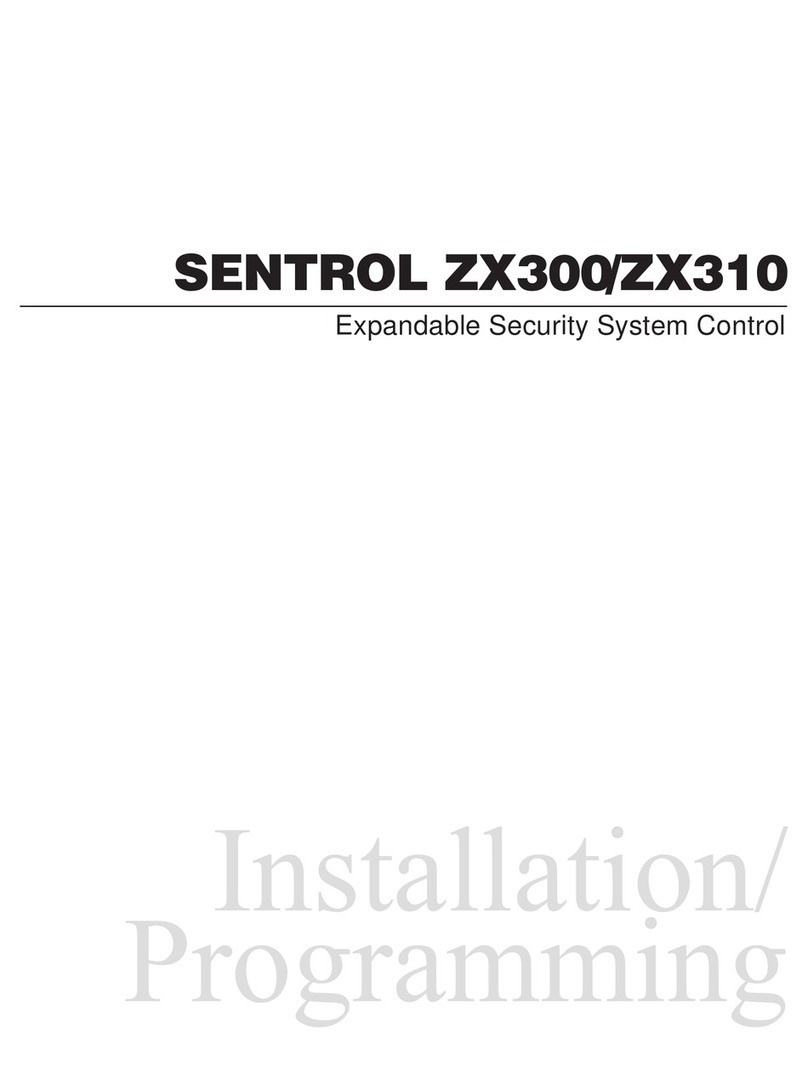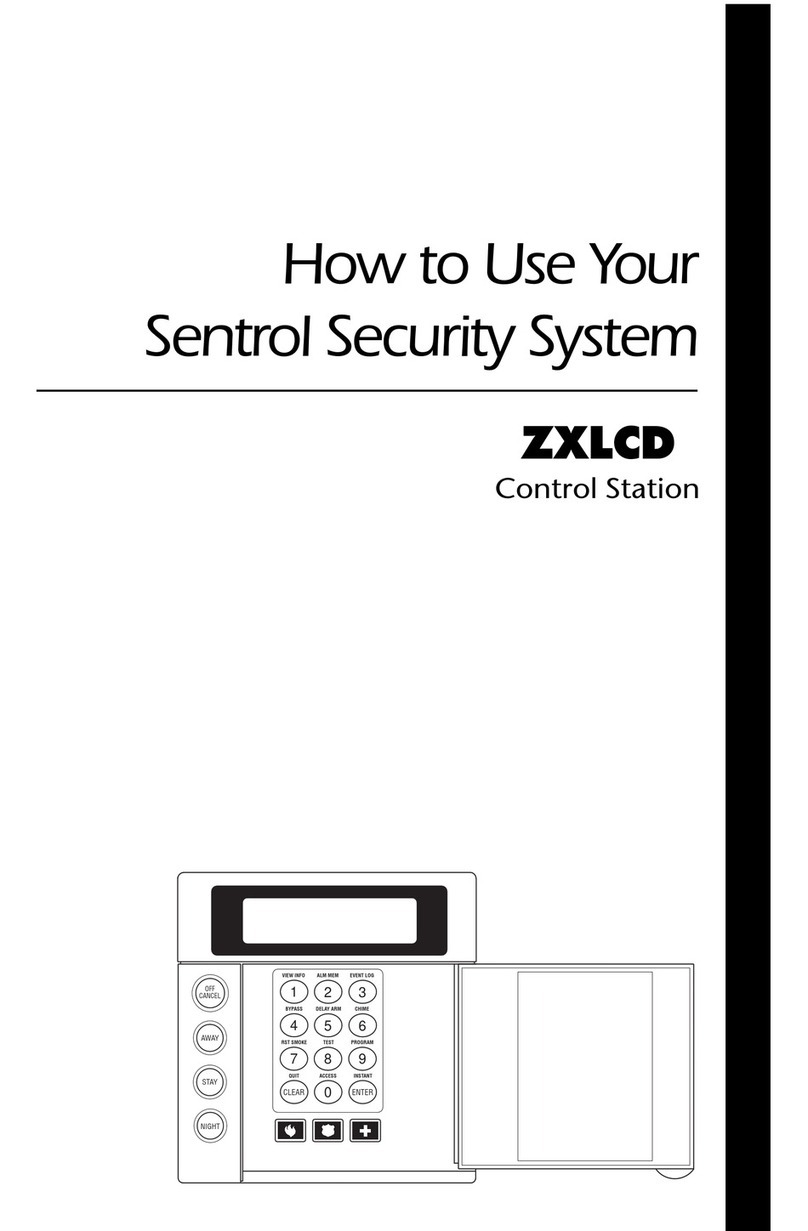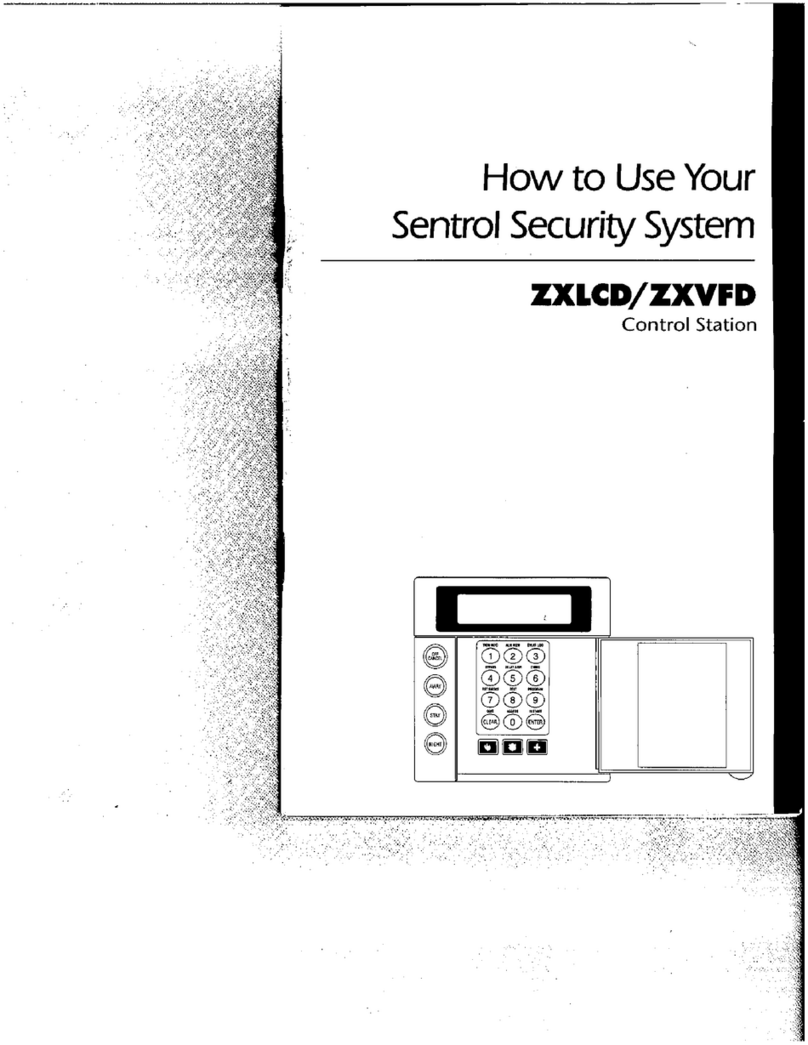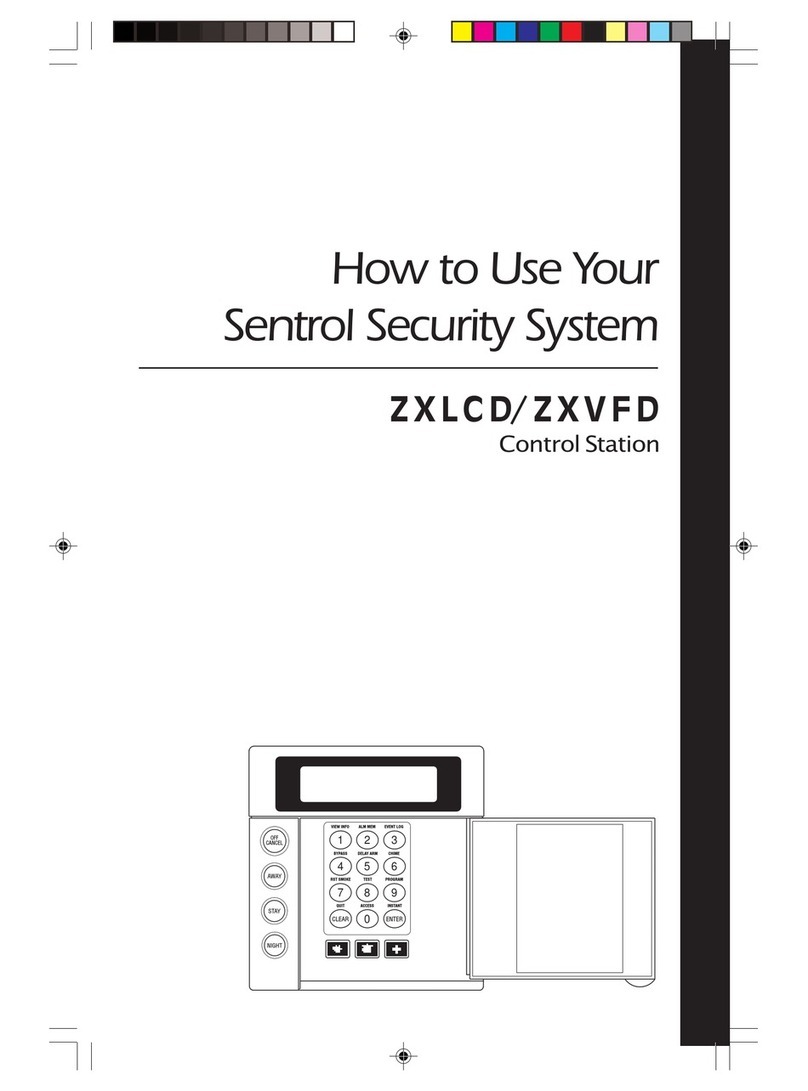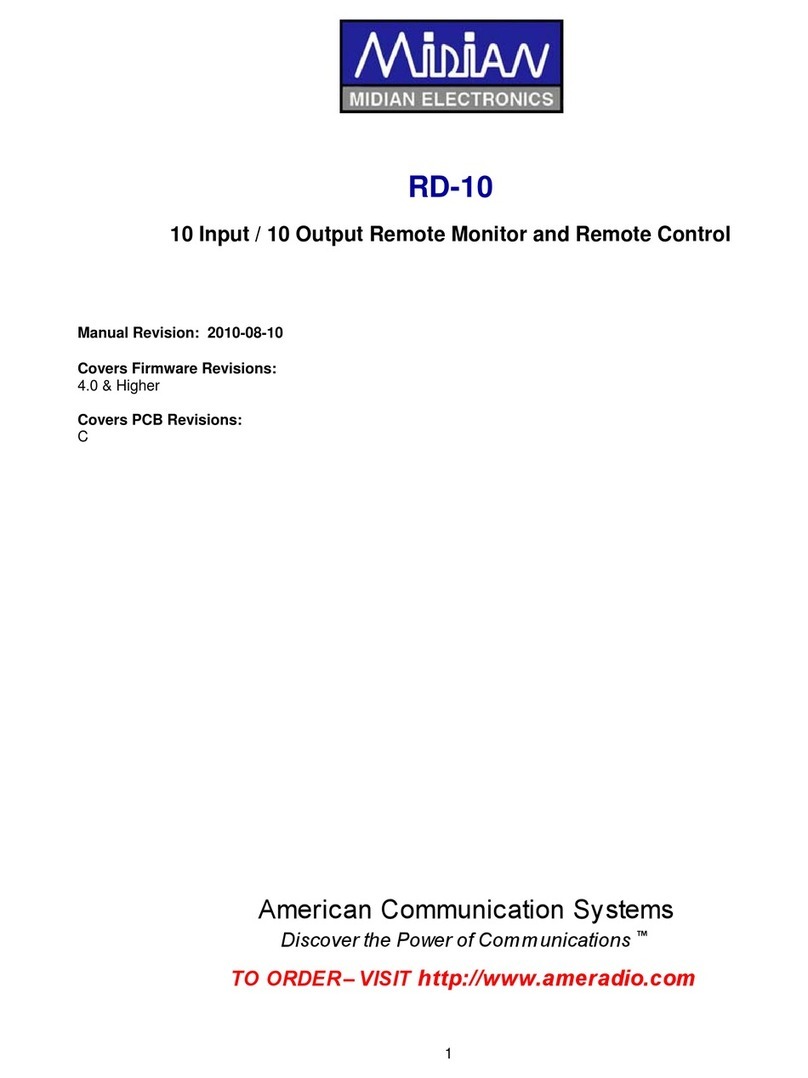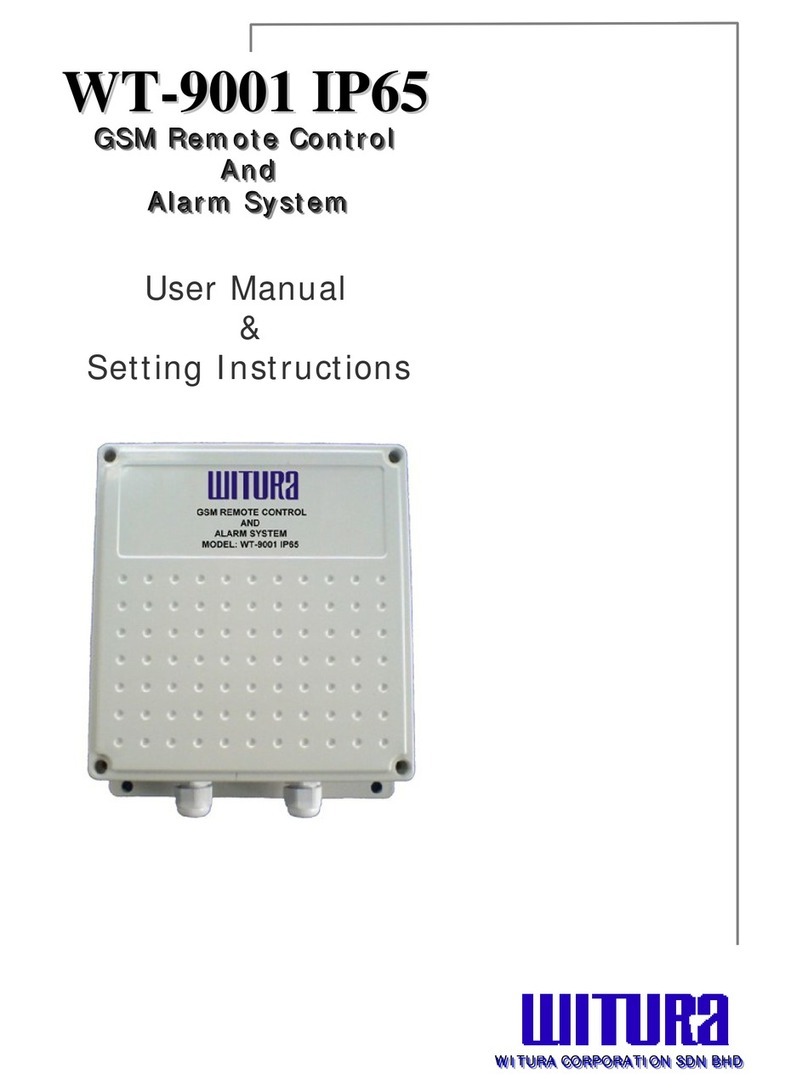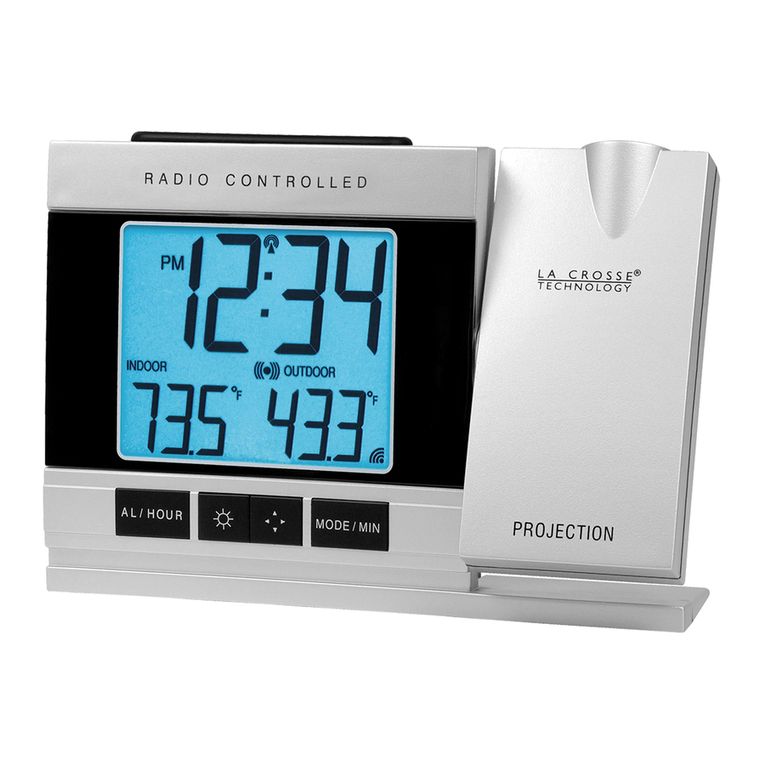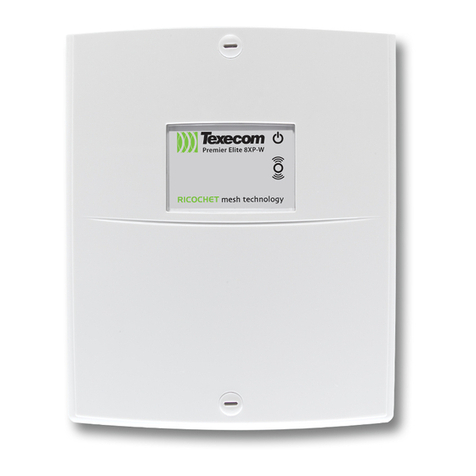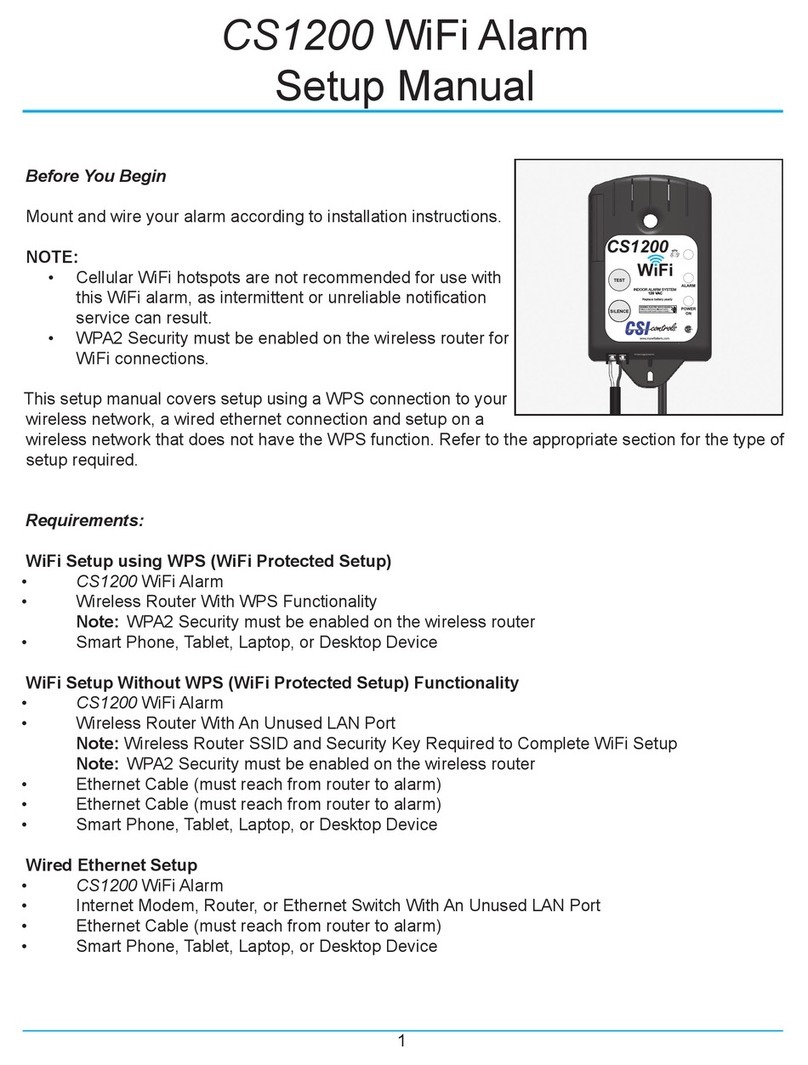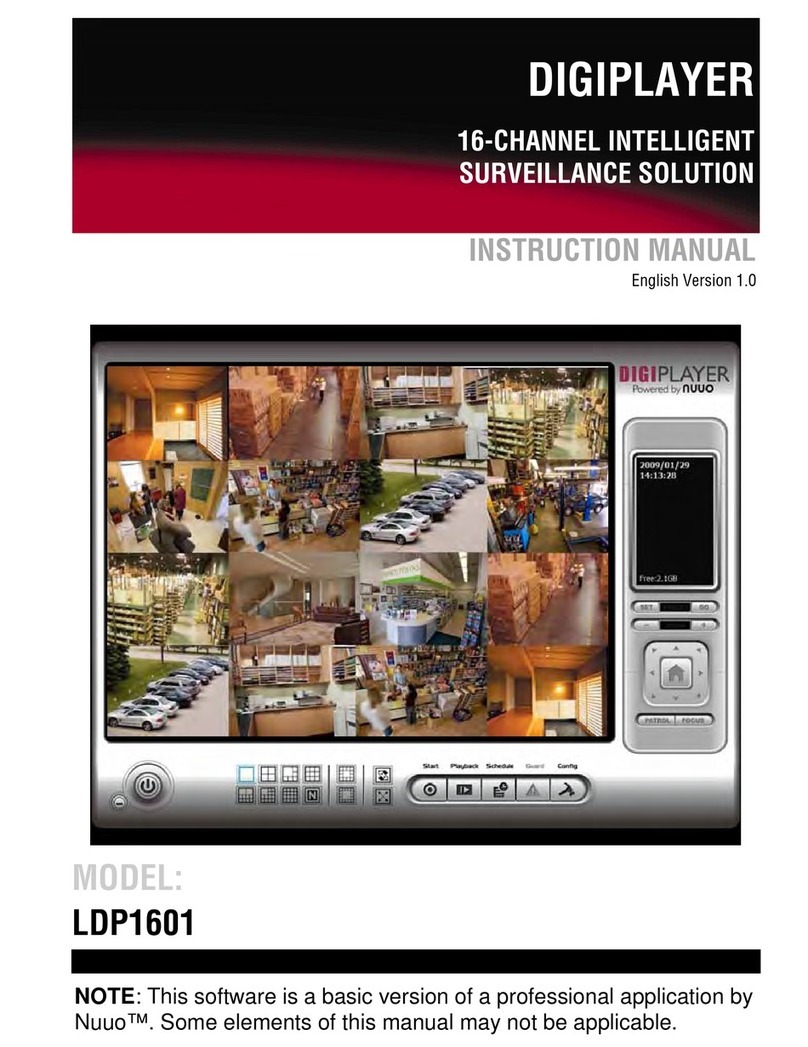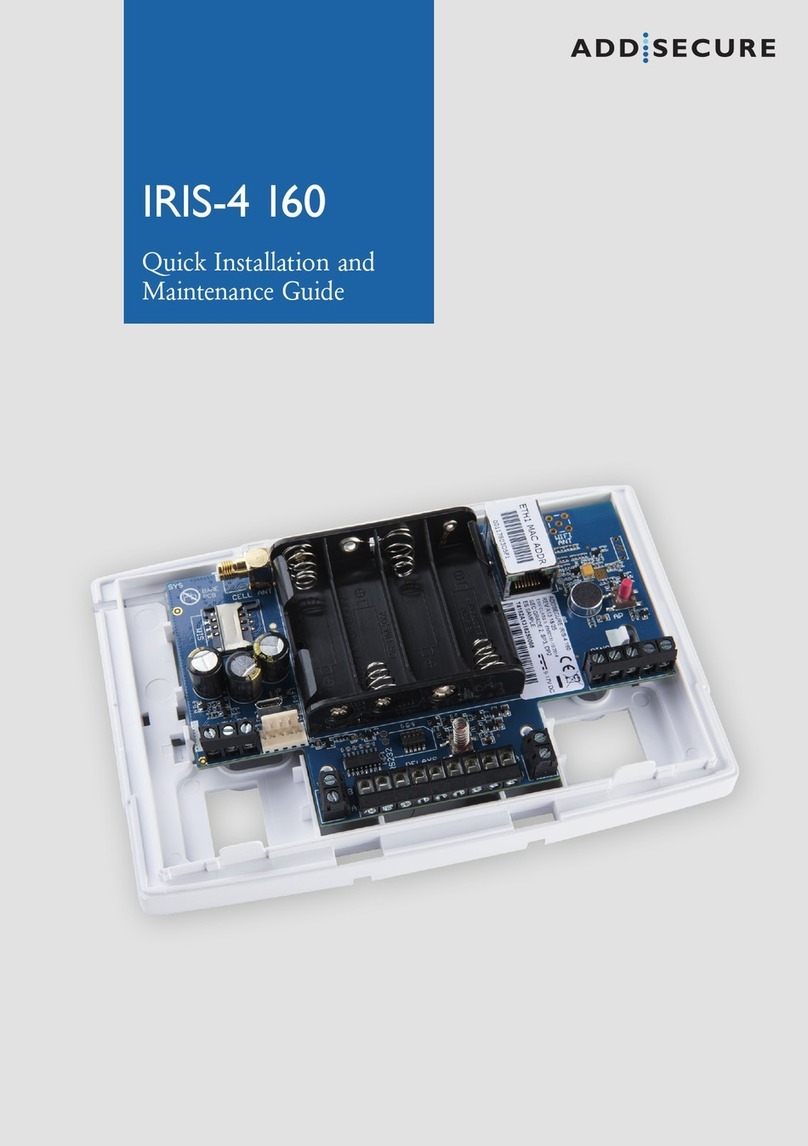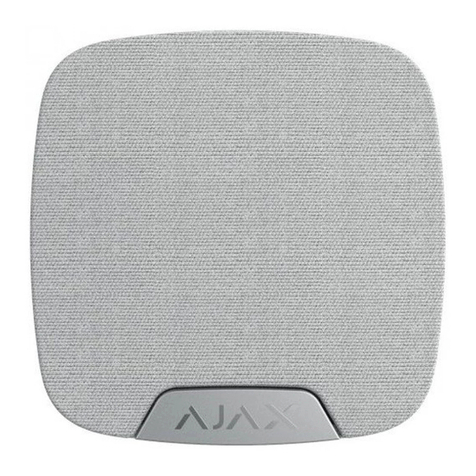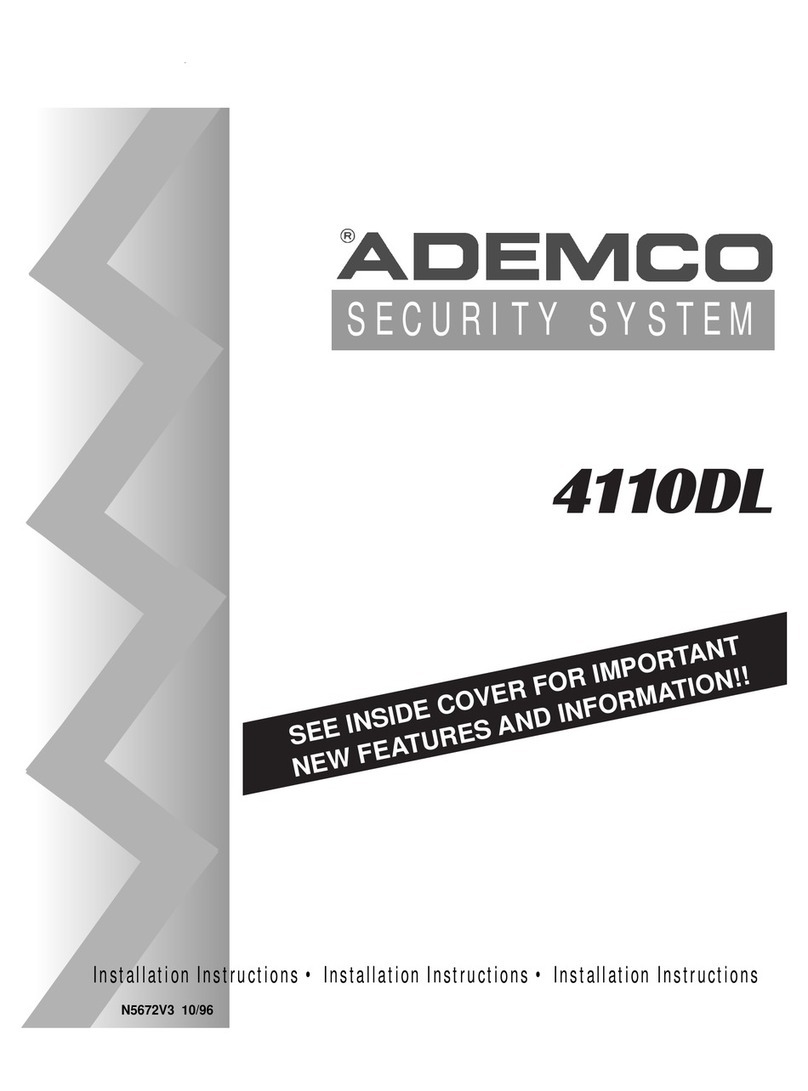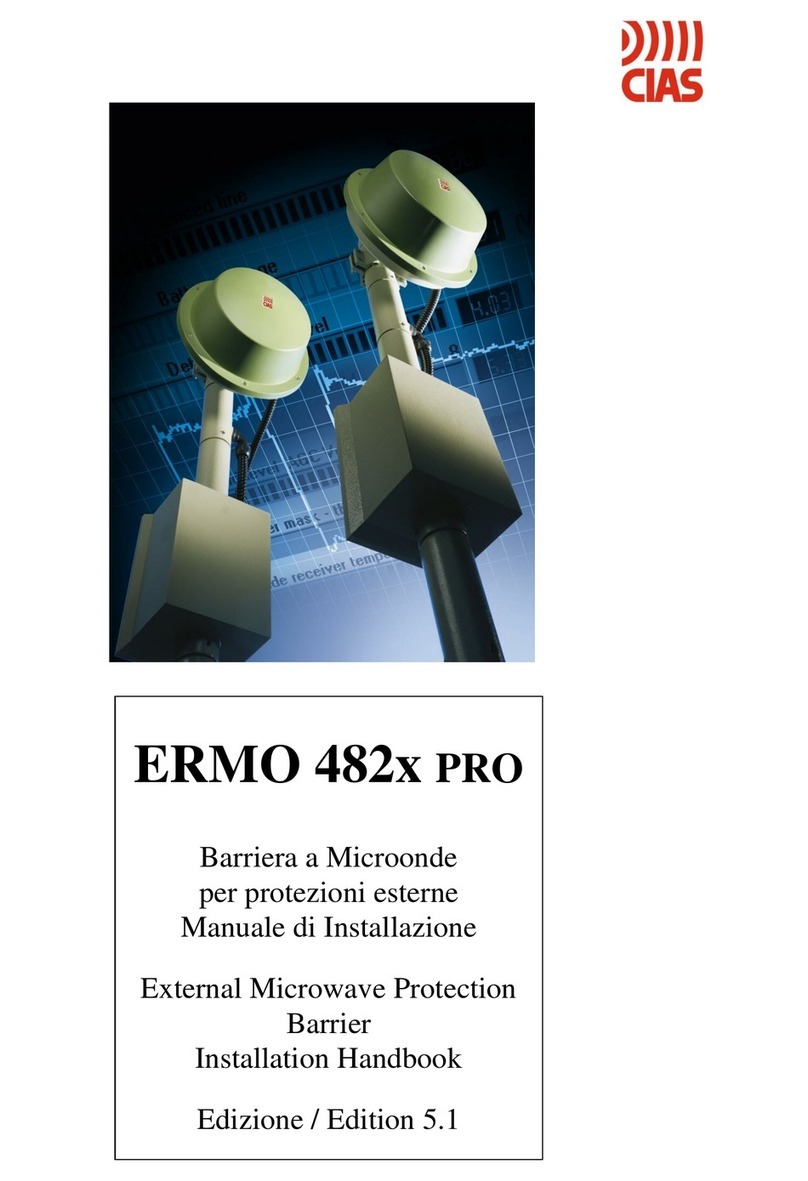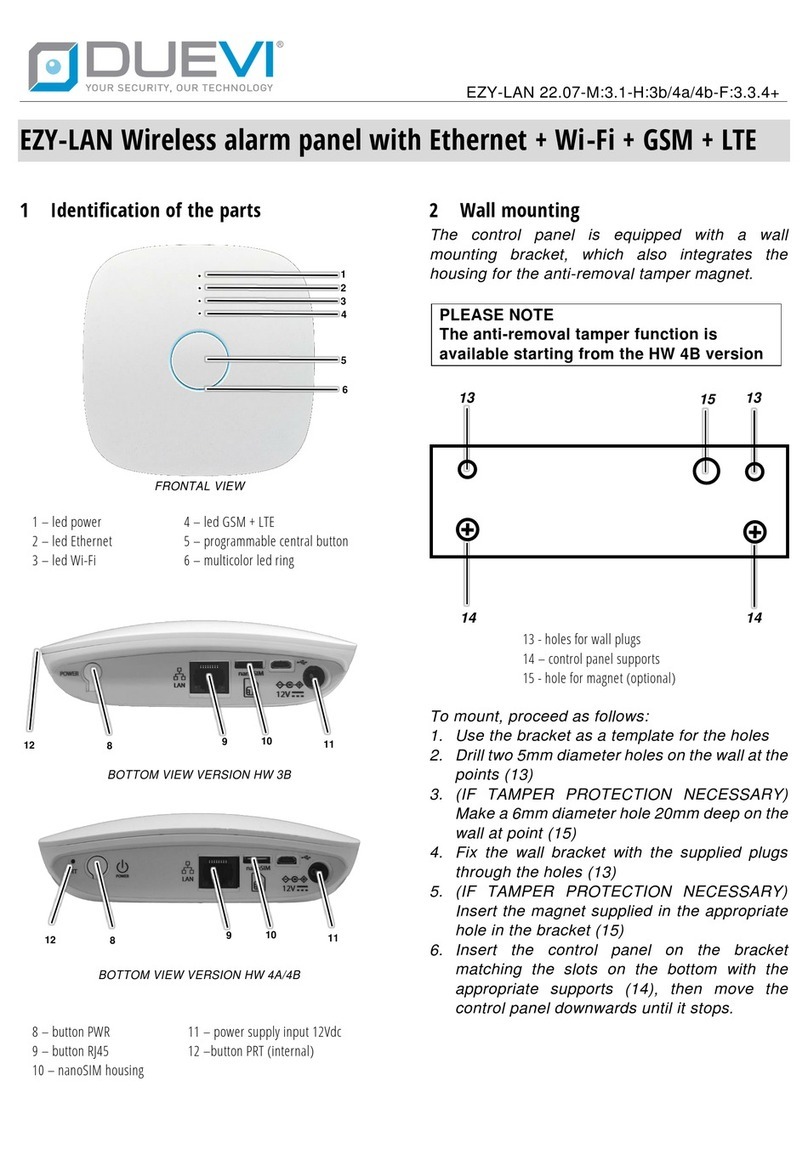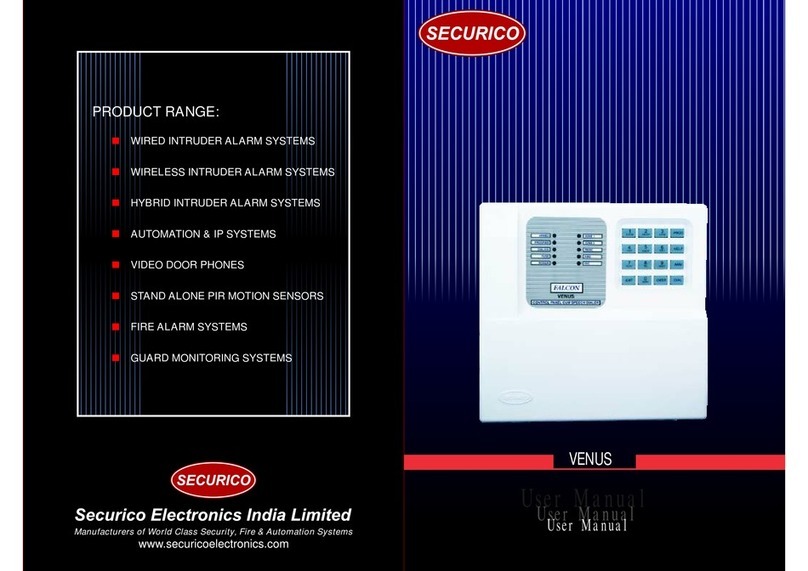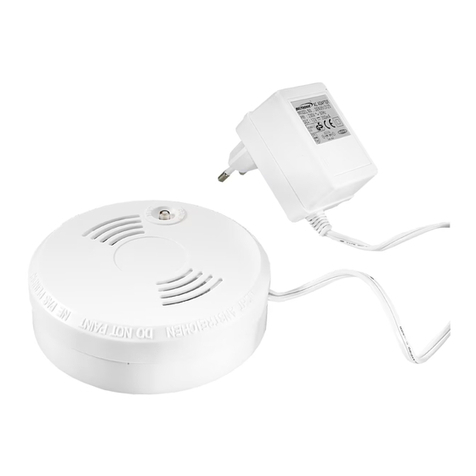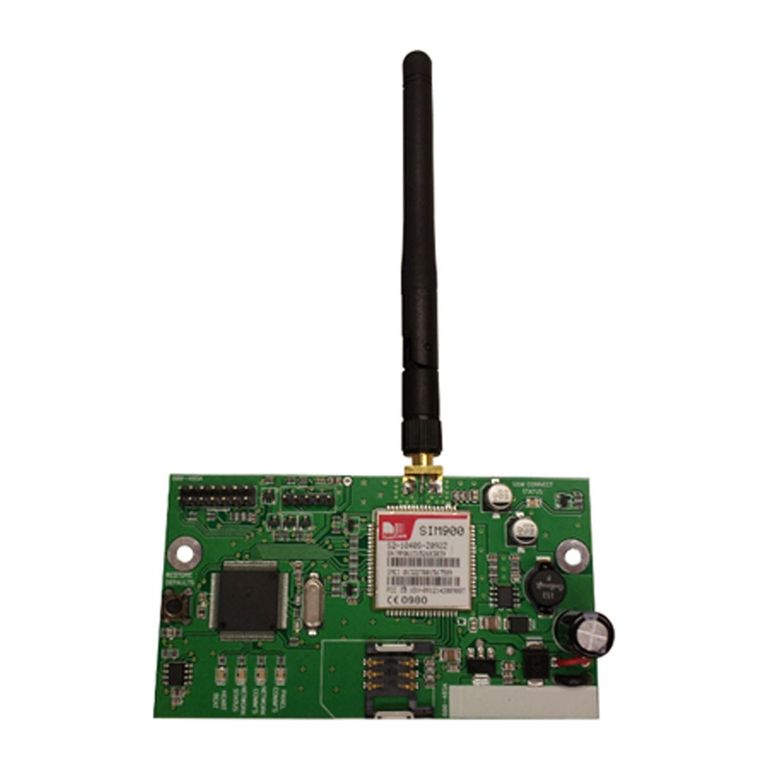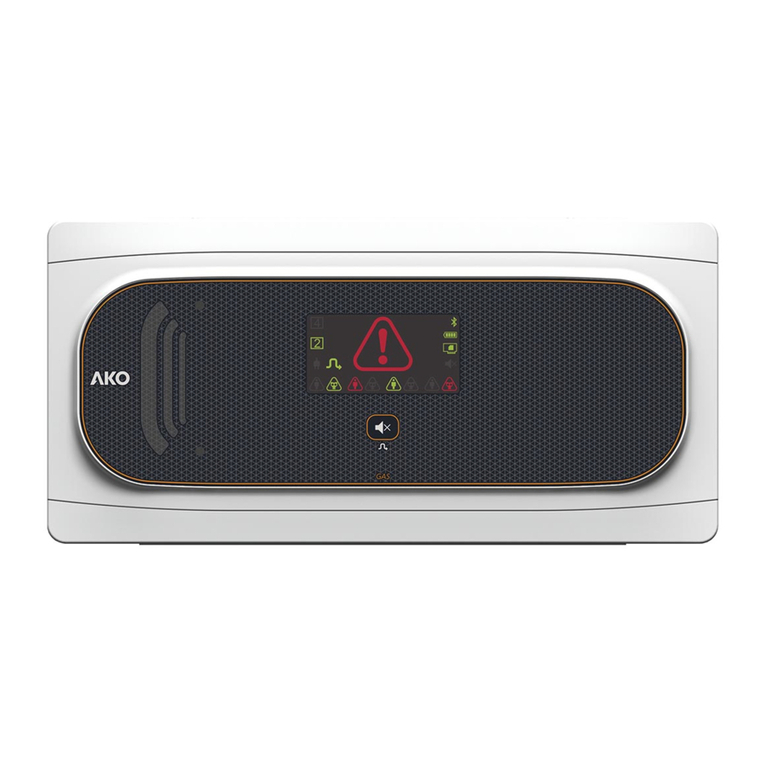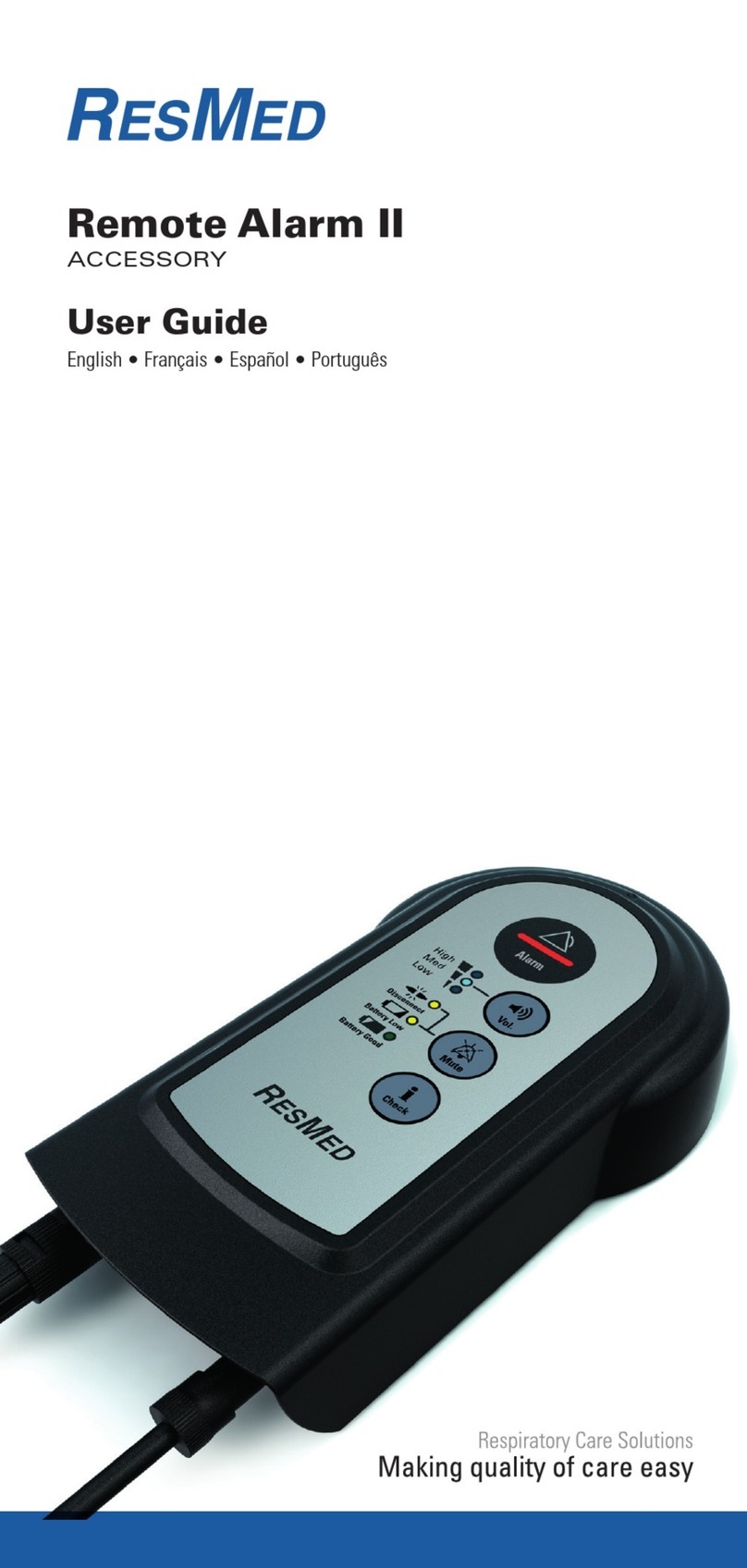
8
2.12.1
2.12.1
2.1 TERMINAL DESCRIPTIONSTERMINAL DESCRIPTIONS
TERMINAL DESCRIPTIONSTERMINAL DESCRIPTIONS
TERMINAL DESCRIPTIONS
2.1.12.1.1
2.1.12.1.1
2.1.1 AA
AA
ACC
CC
C TRANSFORMERTRANSFORMER
TRANSFORMERTRANSFORMER
TRANSFORMER TERMINALS 1 & 2TERMINALS 1 & 2
TERMINALS 1 & 2TERMINALS 1 & 2
TERMINALS 1 & 2
The system is powered with a 16.5V 20VA "non-fused" UL listed
class II transformer. The AC transformer is connected to terminal
1 and 2. It is recommended that the AC transformer be connected
with a minimum of 18 gauge wire at a distance of no more than 50
feet. The AC fail system monitor has a built in 15 second fault delay
that minimizes nuisance alarms caused by momentary power
outages.
NONO
NONO
NOTE:TE:
TE:TE:
TE: Do not connect ADo not connect A
Do not connect ADo not connect A
Do not connect AC poC po
C poC po
C power and bacwer and bac
wer and bacwer and bac
wer and back up batterk up batter
k up batterk up batter
k up batteryy
yy
y
until ALL system wiring is completed. Also do notuntil ALL system wiring is completed. Also do not
until ALL system wiring is completed. Also do notuntil ALL system wiring is completed. Also do not
until ALL system wiring is completed. Also do not
bb
bb
bundle the Aundle the A
undle the Aundle the A
undle the AC wires with zone input or keC wires with zone input or ke
C wires with zone input or keC wires with zone input or ke
C wires with zone input or keypad wires.ypad wires.
ypad wires.ypad wires.
ypad wires.
2.1.22.1.2
2.1.22.1.2
2.1.2 SECONDSECOND
SECONDSECOND
SECONDARAR
ARAR
ARY POY PO
Y POY PO
Y POWER SUPPLWER SUPPL
WER SUPPLWER SUPPL
WER SUPPLY (BY (B
Y (BY (B
Y (BAA
AA
ACK UP BCK UP B
CK UP BCK UP B
CK UP BAA
AA
ATTERTTER
TTERTTER
TTERY)Y)
Y)Y)
Y)
To maintain proper operation, the SC system must have a 12 volt
rechargeable gel type battery installed. The system was designed
to support a 4 to 18 amp hour (AH) battery. The system provides a
float charge of 13.75VDC and provides continuous charging current
when operating at the suggested rated power output.
OnceACpoweris lost tothe system, the battery automatically takes
over. The SC system continuously monitors the battery condition
with or without the AC power removed. If the battery voltage falls to
an 11.0VDC level, the low battery detector will activate and a low
battery
trouble condition will be annunciated at the keypad. The
trouble condition will exist until the battery voltage reaches an
acceptable level.
To silence the trouble enter the fault mode key sequence at the
keypad. [PPPP][PPPP]
[PPPP][PPPP]
[PPPP]++◆
9
▲
+
▲
#
The low battery system monitor also has a built in 15 second fault
delay that minimizes nuisance alarms.
For UL installations,For UL installations,
For UL installations,For UL installations,
For UL installations, refref
refref
refer to sections X and XI,er to sections X and XI,
er to sections X and XI,er to sections X and XI,
er to sections X and XI, ULUL
ULUL
UL
ComplianceCompliance
ComplianceCompliance
Compliance VV
VV
Verification.erification.
erification.erification.
erification.
2.1.32.1.3
2.1.32.1.3
2.1.3 1212
1212
12 VV
VV
VOLOL
OLOL
OLT POT PO
T POT PO
T POWER OUTPUTSWER OUTPUTS
WER OUTPUTSWER OUTPUTS
WER OUTPUTS
AA
AA
AUXILIARUXILIAR
UXILIARUXILIAR
UXILIARY POY PO
Y POY PO
Y POWERWER
WERWER
WERTERMINALS (+12.5VDC 3,TERMINALS (+12.5VDC 3,
TERMINALS (+12.5VDC 3,TERMINALS (+12.5VDC 3,
TERMINALS (+12.5VDC 3, 4,4,
4,4,
4, COMMON 5,6)COMMON 5,6)
COMMON 5,6)COMMON 5,6)
COMMON 5,6)
Unswitched DC power is available for powering auxiliary devices
such as motion detectors. This output is protected by a 2 amp
auxiliary power fuse F2. Negative termination for auxiliary devices
are wired to terminals 5 or 6.
Current requirement for an SK1L, LCD keypad is 100mA.
See Section 9,See Section 9,
See Section 9,See Section 9,
See Section 9, UL ComplianceUL Compliance
UL ComplianceUL Compliance
UL Compliance..
..
.
2.1.42.1.4
2.1.42.1.4
2.1.4 SMOKE POSMOKE PO
SMOKE POSMOKE PO
SMOKE POWER (TERMINALS 10 & 11)WER (TERMINALS 10 & 11)
WER (TERMINALS 10 & 11)WER (TERMINALS 10 & 11)
WER (TERMINALS 10 & 11)
Switched power is available for devices that require an interruptable
power source such as smoke detectors.Negative (switched) termi-
nation for smoke detectors are wired to terminal 11. To enable this
feature a “7” must be programmed in item 30 - Second Miscella-
neous Function select. Once programmed, pressing the [1] and [3]
keys simultaneously will reset the smoke output for approximately 5
seconds.
See Section 9,See Section 9,
See Section 9,See Section 9,
See Section 9, UL ComplianceUL Compliance
UL ComplianceUL Compliance
UL Compliance VV
VV
Verification.erification.
erification.erification.
erification.
2.1.52.1.5
2.1.52.1.5
2.1.5 ASSIGNABLE OUTPUT (TERMINAL 7 & 8)ASSIGNABLE OUTPUT (TERMINAL 7 & 8)
ASSIGNABLE OUTPUT (TERMINAL 7 & 8)ASSIGNABLE OUTPUT (TERMINAL 7 & 8)
ASSIGNABLE OUTPUT (TERMINAL 7 & 8)
Normally this terminal provides a bb
bb
burur
urur
urglarglar
glarglar
glary belly bell
y belly bell
y bell function. If desired,
this terminal can be programmed to follow any one of the items in
table 1, (refer to programming description, item 33). If the assign-
able output has been selected for any function other than burglar
operation, single bellsingle bell
single bellsingle bell
single bell operation must be selected.
NONO
NONO
NOTE:TE:
TE:TE:
TE: The total amount of aThe total amount of a
The total amount of aThe total amount of a
The total amount of avv
vv
vailabailab
ailabailab
ailable current frle current fr
le current frle current fr
le current from the Aom the A
om the Aom the A
om the Auxil-uxil-
uxil-uxil-
uxil-
iariar
iariar
iaryy
yy
y,,
,,
,KK
KK
Kee
ee
eypad,ypad,
ypad,ypad,
ypad, SmokeSmoke
SmokeSmoke
Smoke,,
,,
,and status outputs (Arm,and status outputs (Arm,
and status outputs (Arm,and status outputs (Arm,
and status outputs (Arm, readread
readread
readyy
yy
y,,
,,
,AA
AA
Audibudib
udibudib
udiblele
lele
le
warning,warning,
warning,warning,
warning, and Courand Cour
and Courand Cour
and Courtesy) is 600mA.tesy) is 600mA.
tesy) is 600mA.tesy) is 600mA.
tesy) is 600mA.
For UL installations,For UL installations,
For UL installations,For UL installations,
For UL installations, refref
refref
refer to sections X and XI fer to sections X and XI f
er to sections X and XI fer to sections X and XI f
er to sections X and XI for poor po
or poor po
or powerwer
werwer
wer
loading considerations.loading considerations.
loading considerations.loading considerations.
loading considerations.
+ 12VDC OUTPUT OPTIONS FOR TERMINAL 8
BurgBell(Default) Audiblewarning
Arm/Disarm Courtesy
Strobelight Timercontrol switch
Failtocommunicate Keypad control switch
Arm/Disarm/Alarm P.C. control switch
Readytrouble
2.1.62.1.6
2.1.62.1.6
2.1.6 BELL OUTPUT (TERMINALS 7 & 9)BELL OUTPUT (TERMINALS 7 & 9)
BELL OUTPUT (TERMINALS 7 & 9)BELL OUTPUT (TERMINALS 7 & 9)
BELL OUTPUT (TERMINALS 7 & 9)
If dual bell operationdual bell operation
dual bell operationdual bell operation
dual bell operation is selected, this terminal is activated when-
ever a fire loop is shorted. A 12-14Vdc bell or siren may be
connected to this terminal, providing the current draw of the device
does not exceed 2 amps.
When single bell operationsingle bell operation
single bell operationsingle bell operation
single bell operation is selected, this terminal will have a
steady output for burglary activation and pulsed output for fire
activation. Fire activation has priority over burglary operation.
NONO
NONO
NOTE:TE:
TE:TE:
TE: Single bell operation mSingle bell operation m
Single bell operation mSingle bell operation m
Single bell operation must be used fust be used f
ust be used fust be used f
ust be used for UL installationsor UL installations
or UL installationsor UL installations
or UL installations
and current mand current m
and current mand current m
and current must not eust not e
ust not eust not e
ust not exceed 300mA.xceed 300mA.
xceed 300mA.xceed 300mA.
xceed 300mA.
NONO
NONO
NOTE:TE:
TE:TE:
TE: Single bell operation is indicated bSingle bell operation is indicated b
Single bell operation is indicated bSingle bell operation is indicated b
Single bell operation is indicated by Pry Pr
y Pry Pr
y Programmingogramming
ogrammingogramming
ogramming
item 33 equalling anitem 33 equalling an
item 33 equalling anitem 33 equalling an
item 33 equalling anything eything e
ything eything e
ything except zxcept z
xcept zxcept z
xcept zerer
erer
ero.o.
o.o.
o.
2.1.72.1.7
2.1.72.1.7
2.1.7 REMOREMO
REMOREMO
REMOTE ARMED OUTPUT (TERMINAL 12)TE ARMED OUTPUT (TERMINAL 12)
TE ARMED OUTPUT (TERMINAL 12)TE ARMED OUTPUT (TERMINAL 12)
TE ARMED OUTPUT (TERMINAL 12)
Output is available for connecting a remote armed indicator. Con-
nectthe cathode(-)wire toterminal12andreturnthe anode(+)wire
to terminal 3 or 4. Output will follow panel armed/alarm status.
2.1.82.1.8
2.1.82.1.8
2.1.8 REMOREMO
REMOREMO
REMOTE READTE READ
TE READTE READ
TE READY OUTPUT (TERMINAL 13)Y OUTPUT (TERMINAL 13)
Y OUTPUT (TERMINAL 13)Y OUTPUT (TERMINAL 13)
Y OUTPUT (TERMINAL 13)
Outputisavailable for connectingaremote readyindicator. Connect
the cathode (-) wire to terminal 13 and return the anode wire (+) to
terminals 3 or 4. Output will follow panel ready/trouble status.
NONO
NONO
NOTE:TE:
TE:TE:
TE: DeDe
DeDe
Devices connected to terminals 12 and 13 are not tovices connected to terminals 12 and 13 are not to
vices connected to terminals 12 and 13 are not tovices connected to terminals 12 and 13 are not to
vices connected to terminals 12 and 13 are not to
ee
ee
exceed l0mA current draxceed l0mA current dra
xceed l0mA current draxceed l0mA current dra
xceed l0mA current draww
ww
w..
..
.
2.1.92.1.9
2.1.92.1.9
2.1.9 REMOREMO
REMOREMO
REMOTE ATE A
TE ATE A
TE AUDIBLEUDIBLE
UDIBLEUDIBLE
UDIBLE WW
WW
WARNING OUTPUTARNING OUTPUT
ARNING OUTPUTARNING OUTPUT
ARNING OUTPUT (TERMINAL 14)(TERMINAL 14)
(TERMINAL 14)(TERMINAL 14)
(TERMINAL 14)
Output is available for connecting a remote prealarm device (piezo
or equivalent). The device must operate at 12.5VDC and requires
no more than 50mA of current. Connect the positive (+) wire of the
device to terminal 3 or 4, return the negative (-) wire to terminal 14.
The device will produce a steady tone when in entrance delay and
a pulsating tone when in exit delay, test or trouble modes. When the
Chime feature is enabled this output will operate along with the
keypad sounder for chime, creating a short tone any time a chime
zone is violated or restored.






















